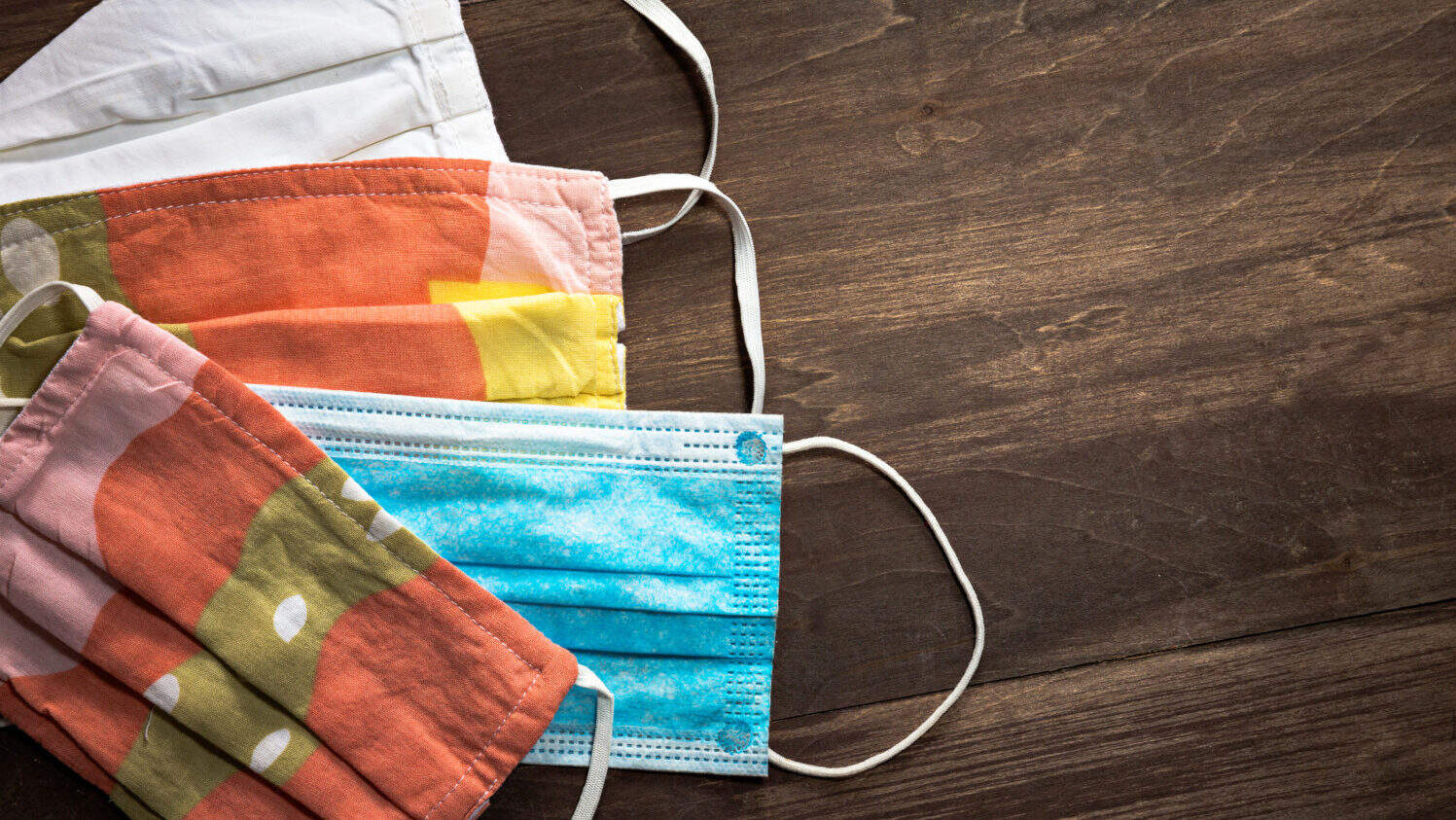Home>Storage Ideas>Bedroom Storage>7 Face Mask Laundry Mistakes You Might Be Making


Bedroom Storage
7 Face Mask Laundry Mistakes You Might Be Making
Modified: December 7, 2023
Avoid these common face mask laundry mistakes to ensure your bedroom storage is properly maintained. Learn how to prolong the life of your masks and keep them clean and effective.
(Many of the links in this article redirect to a specific reviewed product. Your purchase of these products through affiliate links helps to generate commission for Storables.com, at no extra cost. Learn more)
Introduction
As face masks have become an essential part of our daily lives, it’s crucial to ensure that we are properly caring for and laundering them. A clean and well-maintained face mask not only helps to protect us from harmful particles and viruses, but it also ensures their effectiveness and prolongs their lifespan.
In this article, we will explore seven common mistakes people make when washing and storing face masks. By understanding and avoiding these pitfalls, you can keep your face masks clean, hygienic, and ready for use whenever needed.
Key Takeaways:
- Washing new face masks before first use is crucial to remove potential contaminants and ensure a clean, safe, and comfortable wearing experience. Prioritize your health and mask longevity by following this simple step.
- Proper storage, gentle washing, and avoiding common mistakes like using harsh detergents or high heat in the dryer are essential for maintaining the cleanliness, hygiene, and effectiveness of your face masks. Protect yourself and others by giving your masks the care they deserve.
Read more: How To Store Face Mask
Mistake #1: Not Washing Before First Use
One of the most common mistakes people make when acquiring new face masks is failing to wash them before their first use. It’s important to remember that face masks often go through various stages of production, packaging, and transportation, which can leave behind residue, dirt, or even chemicals.
By washing your face masks before wearing them for the first time, you remove any potential contaminants, ensuring a clean and safe experience. Washing also helps to soften the fabric, making it more comfortable against your skin.
To wash your new face mask, simply follow the manufacturer’s instructions. In most cases, a gentle machine or hand wash with mild detergent will suffice. Ensure that you thoroughly rinse the mask and allow it to air dry completely before using it. This step will help eliminate any potential irritants while ensuring that the mask fits properly and effectively filters out particles.
By taking the time to wash newly acquired face masks, you prioritize your health and well-being, while also contributing to the longevity and durability of the mask itself.
Mistake #2: Not Checking the Washing Instructions
Each face mask may have specific washing instructions provided by the manufacturer. Ignoring or neglecting to check these instructions can lead to damage or reduced effectiveness of the mask.
Before tossing your face mask into the washing machine or handwashing it, take a moment to look for any tags or labels that indicate proper care instructions. These instructions may include recommended water temperature, cycle type, and specific detergents to use or avoid.
Some face masks may require gentle cycles or handwashing to prevent stretching or tearing of the fabric. Others may require a specific water temperature to effectively kill any bacteria or viruses. By adhering to these instructions, you ensure that your face mask remains clean, intact, and capable of providing the necessary level of protection.
Furthermore, some face masks may recommend air drying instead of using a dryer. Heat can potentially damage the fabric or alter the integrity of any filters present in the mask. Following the suggested drying method helps to maintain the shape and functionality of the face mask.
Checking the washing instructions may take just a few moments but can make a significant difference in how well your face mask retains its quality and protective properties. Take the extra step and give your face masks the care they deserve.
Mistake #3: Using Harsh Detergents or Bleach
When it comes to washing face masks, using the right detergent is crucial. Many people make the mistake of using harsh detergents or bleach, which can be detrimental to the mask’s fabric and the overall quality of the mask.
Harsh detergents, such as those containing strong chemicals or fragrances, can irritate the skin and cause discomfort when wearing the mask. They can also weaken the fibers of the mask, leading to wear and tear over time.
Similarly, bleach may seem like a good option for disinfecting face masks, but it can damage the fabric and affect the mask’s structural integrity. Additionally, bleach can cause discoloration and may leave behind a strong odor, which can be unpleasant to wear.
Instead, opt for mild and fragrance-free detergents specifically formulated for delicate fabrics. These detergents are gentle on the mask’s material while effectively removing dirt and bacteria. Look for detergents that are suitable for use on sensitive skin, as they will minimize the risk of irritation.
If you’re looking for a natural alternative, consider using a mixture of mild soap and warm water. This gentle solution can effectively cleanse the mask without compromising its quality.
Remember, using the right detergent is essential for maintaining the cleanliness and integrity of your face masks. By avoiding harsh chemicals and bleach, you’ll ensure that your masks remain comfortable, effective, and long-lasting.
Mistake #4: Not Washing Masks Often Enough
Another common mistake people make when it comes to face mask care is not washing them often enough. Regular washing is crucial to keep your face masks clean, free from bacteria, and functioning effectively.
How frequently you should wash your face masks depends on a few factors, including how often you wear them and the level of exposure to potentially harmful particles. As a general guideline, it’s recommended to wash reusable cloth masks after every use.
If you wear a face mask for an extended period or in high-risk environments, such as crowded places or medical facilities, consider washing it more frequently. The more you wear the mask, the higher the chances of it accumulating dirt, oils, and bacteria.
It’s also important to note that if your face mask becomes visibly dirty or moist, it’s time to wash it immediately, regardless of the number of uses. These conditions can compromise the effectiveness of the mask and increase the risk of contamination.
By washing your face masks regularly, you eliminate any potential buildup of germs or debris, ensuring that your masks provide optimal protection. It also helps to maintain freshness and hygiene, promoting a comfortable and safe wearing experience.
Make a habit of incorporating face mask laundering into your routine, just like washing your clothes or doing the dishes. Set a reminder or establish a specific day or time dedicated to cleaning your face masks. By doing so, you’ll prioritize your health and the longevity of your masks.
To prevent damaging your face masks, always use a gentle detergent and avoid using bleach or fabric softener. Wash them in warm water and air dry to maintain their effectiveness.
Mistake #5: Overstuffing the Washing Machine
When it comes to washing face masks, it’s important not to overcrowd the washing machine. Overstuffing the machine can lead to ineffective cleaning, inadequate rinsing, and even damage to the masks.
Overcrowding the washing machine prevents the proper circulation of water and detergent, hindering the thorough cleaning of the masks. It can also cause excessive friction between the masks, leading to wear and tear or even distortion of their shape.
To ensure a proper and effective wash, leave enough space in the washing machine for the masks to move freely. This allows the water and detergent to penetrate the fabric and remove any dirt, oils, or particles trapped within.
If you have a large number of masks to wash, consider dividing them into smaller loads or wash them in multiple cycles. This way, each mask receives the attention and care it needs to be thoroughly cleaned.
In addition to preventing overcrowding, it’s important to select the appropriate water level and cycle for your masks. Check the manufacturer’s instructions to determine the recommended settings. For example, some masks may require a gentle cycle, while others can be safely washed in a regular cycle.
By avoiding the mistake of overstuffing the washing machine, you ensure that your face masks receive the proper cleaning they deserve. This not only keeps them hygienic and fresh but also maintains their durability and effectiveness in filtering out particles effectively.
Mistake #6: Using High Heat in the Dryer
When it comes to drying your face masks, using high heat in the dryer can be a common mistake that people make. Excessive heat can damage the fabric, cause shrinkage, and even compromise the integrity of any filter material present in the mask.
High heat can cause the elastic bands or adjustable straps on the mask to degrade or lose their elasticity, making the mask less secure and comfortable to wear. It can also weaken the fibers of the mask, leading to fraying or tearing.
To properly dry your face masks, it’s recommended to use a low or delicate setting on your dryer. This gentle heat will help to remove moisture without subjecting the masks to excessive heat that can be damaging.
If possible, opting for air drying is the best option for drying face masks. Hanging the masks on a clothesline or laying them flat on a clean, dry surface allows them to dry naturally without any heat or potential damage.
Remember to place the masks in a well-ventilated area to ensure proper airflow, which aids in faster drying and helps to prevent any mildew or odor from developing.
By avoiding high heat in the dryer and opting for gentle drying methods, you can preserve the integrity and quality of your face masks. This ensures that they remain in good condition, ready for use whenever you need them.
Mistake #7: Not Storing Clean Masks Properly
After washing and drying your face masks, it’s essential to store them properly to maintain their cleanliness and ensure they’re ready for use when needed. Unfortunately, not storing clean masks properly is a common mistake that people make.
Leaving clean masks lying around can expose them to dust, dirt, or other contaminants, rendering them less hygienic and potentially compromising their effectiveness. Proper storage is especially important for masks that you plan to use on a regular basis.
One effective way to store clean masks is to use individual storage bags or pouches. These can be made of fabric or plastic and should be clean and dry before placing the masks inside. Individual storage ensures that each mask remains clean and separated from other items in your bag or drawer.
Another option is to use a dedicated container or box for storing your face masks. This can be a small bin, a shoebox, or any other clean and enclosed container that keeps the masks protected from external elements.
Make sure to label the storage bags or containers with the date of when the masks were last washed. This helps you keep track of their usage and reminds you when it’s time to wash them again, especially if you rotate through multiple masks.
Lastly, store your face masks in a cool, dry, and well-ventilated area. Avoid storing them in direct sunlight or in excessively humid environments, as this can potentially harbor mold or bacteria.
By implementing proper storage practices, you ensure that your clean masks are protected and ready for use. This not only maintains their cleanliness but also contributes to their longevity and effectiveness as a protective barrier.
Conclusion
Caring for and laundering your face masks properly is essential for maintaining their cleanliness, hygiene, and effectiveness. By avoiding common mistakes, you can ensure that your masks are ready for use whenever you need them, providing you with the necessary protection against harmful particles and viruses.
First and foremost, remember to wash your face masks before their first use to eliminate any potential contaminants. Checking the washing instructions provided by the manufacturer is crucial to prevent damage and ensure proper care. Using gentle detergents or mild soap, rather than harsh chemicals or bleach, preserves the integrity of the masks and minimizes skin irritation.
Washing your masks frequently is essential for keeping them clean and hygienic. Avoid overcrowding the washing machine to allow proper cleaning and rinsing. Using high heat in the dryer can damage the fabric and elastic, so opt for low heat settings or air drying when possible.
Lastly, store your clean masks properly in individual storage bags or designated containers to protect them from dust, dirt, and other contaminants. Make sure to label them with the date of washing to keep track of their usage and when they require cleaning again.
By following these guidelines and avoiding these common mistakes, you can ensure the longevity and effectiveness of your face masks. Remember, proper care and maintenance not only contribute to your safety but also promote a comfortable and hygienic wearing experience.
Take the extra step and prioritize the proper care of your face masks. By doing so, you can have peace of mind knowing that you are doing everything you can to protect yourself and others in these challenging times.
Frequently Asked Questions about 7 Face Mask Laundry Mistakes You Might Be Making
Was this page helpful?
At Storables.com, we guarantee accurate and reliable information. Our content, validated by Expert Board Contributors, is crafted following stringent Editorial Policies. We're committed to providing you with well-researched, expert-backed insights for all your informational needs.















0 thoughts on “7 Face Mask Laundry Mistakes You Might Be Making”